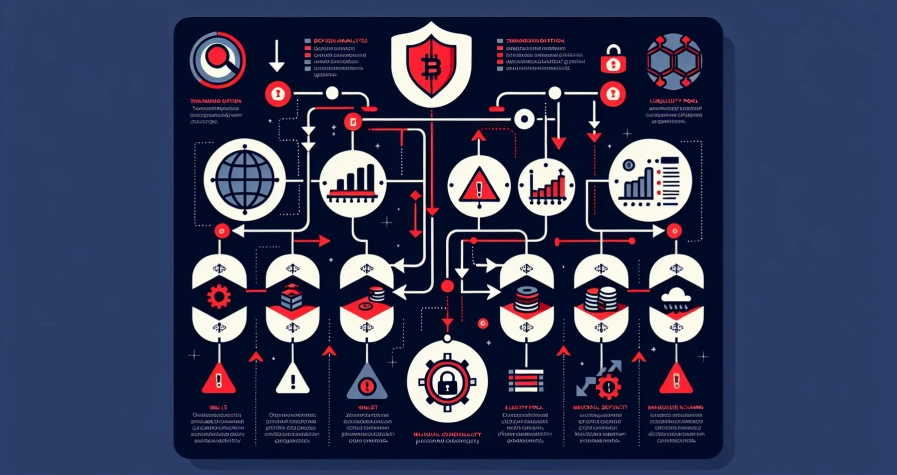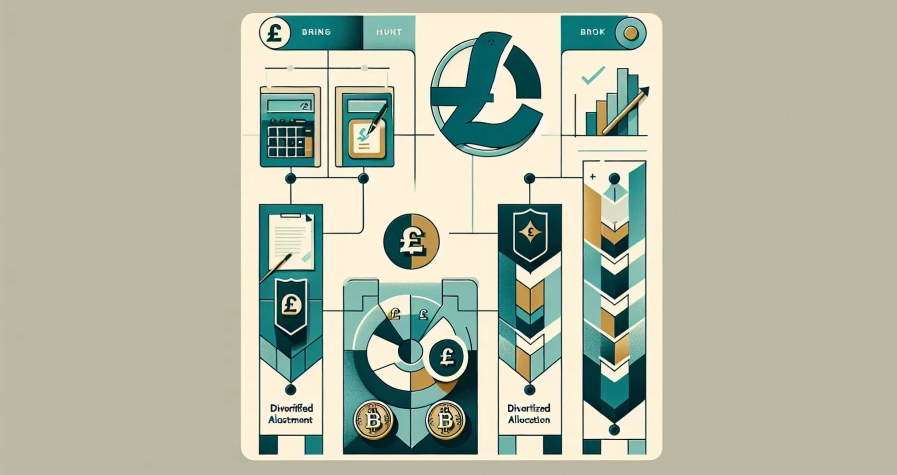Key Takeaways
- Sidechains are independent blockchain networks that run parallel to main blockchains like Bitcoin or Ethereum, connected through secure two-way bridges that enable asset transfers whilst maintaining separate consensus mechanisms and enhanced functionality.
- They solve critical scalability issues by processing transactions independently from congested main networks, offering dramatically reduced fees (£0.001-£0.10 versus £15-50+ on mainnet) and faster confirmation times of 1-30 seconds compared to Bitcoin’s 10-minute blocks.
- Three main types exist with different trust models: federated sidechains (controlled by trusted parties like Liquid Network), merge-mined sidechains (secured by parent chain miners), and hybrid models that combine elements from both approaches.
- Popular examples demonstrate practical benefits including Polygon for Ethereum scaling with over 3 million daily transactions, Liquid Network for faster Bitcoin transfers, and RSK for bringing smart contract functionality to Bitcoin.
- Security trade-offs require careful consideration as sidechains operate with independent validator sets and consensus mechanisms, creating potential vulnerabilities in bridge protocols and introducing higher centralisation risks compared to their parent blockchains.
- They differ significantly from Layer 2 solutions by maintaining independent security models rather than inheriting mainnet security, offering greater customisation flexibility but requiring additional trust assumptions and longer asset transfer times.
Cryptocurrency’s rapid evolution has brought countless innovations to solve scalability and efficiency challenges. Among these groundbreaking solutions, sidechains have emerged as a game-changing technology that’s reshaping how blockchain networks operate.
You’ve likely heard the term “sidechain” thrown around in crypto circles, but understanding what they actually do can seem daunting. Simply put, sidechains are independent blockchains that run parallel to main networks like Bitcoin or Ethereum, offering enhanced functionality whilst maintaining crucial connections to their parent chains.
These parallel networks aren’t just technical curiosities – they’re practical solutions addressing real problems you might face when using cryptocurrencies. From reducing transaction fees to enabling faster processing times and introducing new features, sidechains are becoming essential infrastructure in the digital asset ecosystem. Whether you’re a seasoned trader or just beginning your crypto journey, grasping how sidechains work will give you valuable insight into blockchain technology’s future.
What Are Sidechains in Crypto?
Sidechains are independent blockchain networks that connect to parent blockchains through two-way bridges. These secondary networks operate with their own consensus mechanisms whilst maintaining a secure connection to the main blockchain. You can transfer digital assets between the primary chain and sidechain through specialised protocols that lock tokens on one network and release equivalent tokens on the other.
The technical architecture of sidechains involves three core components: the main blockchain, the sidechain network, and the bridging mechanism. Your transactions on a sidechain process independently of the parent chain, allowing for different block times, consensus algorithms, and transaction throughput rates. Popular examples include Polygon (connected to Ethereum), Lightning Network (connected to Bitcoin), and Liquid Network (also connected to Bitcoin).
Sidechains differ from traditional scaling solutions because they maintain their own security models and governance structures. You interact with sidechains using separate wallets and interfaces, though many modern applications seamlessly integrate both networks. The bridging process typically requires confirmation periods ranging from several minutes to hours, depending on the specific implementation and security requirements.
| Sidechain Feature | Description | Typical Value |
|---|---|---|
| Block Time | Time between new blocks | 2-15 seconds |
| Transaction Fees | Cost per transaction | £0.001-£0.10 |
| Confirmation Time | Transaction finality | 1-30 seconds |
| Bridge Transfer Time | Asset movement duration | 5 minutes-24 hours |
Your understanding of sidechains becomes essential when exploring decentralised finance applications, non-fungible token marketplaces, and high-frequency trading platforms. These networks enable developers to experiment with new features without compromising the security or stability of the main blockchain. Sidechains support smart contract functionality even when connected to blockchains that don’t natively support programmable transactions, such as Bitcoin.
How Sidechains Work
Sidechains function through sophisticated mechanisms that enable secure asset transfers whilst maintaining independent operations from their parent blockchains. These networks utilise specialised protocols to process transactions separately from the main blockchain, creating efficient pathways for digital asset movement.
Two-Way Peg Mechanism
The two-way peg serves as the fundamental bridge connecting your assets between the main blockchain and sidechain networks. This mechanism operates through automated lockboxes on both chains, where your digital assets become temporarily frozen on the origin blockchain before equivalent amounts unlock on the destination chain.
Smart contracts manage the entire locking and unlocking process, ensuring your asset transfers remain secure and trustless. When you move cryptocurrency from the mainchain to a sidechain, the system locks your original tokens whilst simultaneously creating corresponding tokens on the sidechain. The reverse process occurs when you transfer assets back, maintaining consistent total supply across both networks.
Security protocols include mandatory waiting periods during transfers, typically ranging from 15 minutes to several hours depending on the specific sidechain implementation. These waiting periods prevent double-spending attacks and provide validation time for network nodes to confirm transaction legitimacy.
| Transfer Direction | Lock Time | Validation Period | Asset State |
|---|---|---|---|
| Mainchain to Sidechain | Immediate | 15-60 minutes | Locked/Created |
| Sidechain to Mainchain | Immediate | 1-7 days | Created/Unlocked |
Consensus Models
Consensus protocols on sidechains operate independently from their parent blockchain networks, allowing you to experience different validation mechanisms tailored to specific use cases. Popular sidechain consensus models include Proof of Stake, Delegated Proof of Stake, and federated consensus systems managed by trusted validator sets.
Proof of Stake sidechains enable you to participate in network validation by staking tokens, typically offering faster block times between 2-5 seconds compared to Bitcoin’s 10-minute intervals. Federated consensus models rely on pre-selected validator nodes, providing enterprise-grade security whilst maintaining rapid transaction processing speeds.
Authority-based consensus systems allow specific organisations or individuals to validate transactions, creating permissioned networks suitable for institutional applications. These models prioritise speed and regulatory compliance over complete decentralisation, processing thousands of transactions per second whilst maintaining connection to the parent blockchain’s security guarantees.
Different consensus mechanisms directly impact your transaction costs, with sidechain fees typically ranging from $0.001 to $0.10 compared to mainchain fees that can exceed $50 during network congestion periods.
Types of Sidechains
Sidechains implement different security models and governance structures depending on their intended use cases and trust requirements. Understanding these distinct categories helps you choose the most suitable sidechain for your specific cryptocurrency operations.
Federated Sidechains
Federated sidechains operate under the control of a predetermined group of signatories who manage asset transfers between the main blockchain and sidechain network. You deposit your assets into a multisignature contract that’s overseen by this federation of trusted parties.
The federation controls both the locking and unlocking of assets on the mainnet whilst simultaneously managing block production on the sidechain. This centralised approach provides enhanced security through established trust relationships but introduces counterparty risk since you’re relying on the federation’s honesty and operational competence.
Liquid Network exemplifies this model by serving as Bitcoin’s federated sidechain, enabling faster transactions and confidential transfers through a network of cryptocurrency exchanges and financial institutions. The federation approach works particularly well for institutional users who require predictable settlement times and established regulatory frameworks.
Merge-Mined Sidechains
Merge-mined sidechains leverage the same proof-of-work miners that secure their parent blockchain, creating a symbiotic relationship that enhances security without requiring additional mining infrastructure. You benefit from the parent chain’s established mining power whilst accessing the sidechain’s specialized functionality.
Miners simultaneously validate transactions on both the main blockchain and the sidechain through auxiliary proof-of-work, sharing their computational resources across both networks. This arrangement ties the sidechain’s security directly to the main chain’s hash rate, providing robust protection against attacks.
Drivechains represent an emerging example of merge-mined sidechains designed to expand Bitcoin’s functionality whilst maintaining decentralisation. The merge-mining approach offers superior security compared to independent consensus mechanisms but requires miner adoption and technical integration with existing mining operations.
Hybrid Sidechains
Hybrid sidechains combine elements from federated and merge-mined models, creating customised solutions that balance trust assumptions with operational requirements. You encounter these networks when projects require specific security properties that single-model approaches can’t adequately address.
These implementations might feature partial federation with elements of decentralised mining or combine proof-of-stake validation with federated bridge management. The hybrid approach allows developers to optimise for particular use cases whilst addressing the limitations of pure federated or merge-mined systems.
Hybrid models typically emerge in enterprise applications or specialised DeFi protocols where standard sidechain architectures don’t meet specific regulatory compliance or performance requirements. The flexibility comes at the cost of increased complexity in both implementation and user understanding of the underlying trust model.
Benefits of Sidechains
Sidechains deliver substantial advantages that address critical limitations in traditional blockchain networks. These independent networks enhance your cryptocurrency experience through improved performance, privacy, and functionality.
Scalability Solutions
Scalability solutions represent the primary advantage you gain from implementing sidechains in your blockchain operations. Sidechains alleviate congestion on main blockchains by offloading transaction processing and data storage to separate networks. This architectural approach reduces transaction fees and accelerates processing speeds significantly.
Networks like Bitcoin and Ethereum experience substantial congestion issues that result in slow transaction speeds and elevated costs. Sidechains resolve these challenges by processing high-volume transactions independently from the parent chain. Polygon demonstrates this scalability improvement by enabling high-volume, low-latency transactions on the Ethereum ecosystem. The Liquid Network facilitates rapid Bitcoin transactions whilst maintaining security standards equivalent to the main blockchain.
Transaction throughput increases dramatically when you utilise sidechain networks compared to traditional mainchain processing. These performance improvements make sidechains particularly valuable for applications requiring frequent transactions such as decentralised exchanges, gaming platforms, and micropayment systems.
Enhanced Privacy Features
Enhanced privacy features distinguish sidechains from their parent blockchains through advanced cryptographic implementations. Sidechains implement their own consensus mechanisms, allowing for sophisticated privacy techniques that aren’t feasible on main networks. These privacy enhancements improve security and confidentiality without compromising the integrity of the parent blockchain.
Privacy-focused sidechains employ zero-knowledge proofs, ring signatures, and stealth addresses to obscure transaction details from public view. These cryptographic methods ensure your financial activities remain confidential whilst maintaining verifiable transaction records. Advanced mixing protocols on sidechains further anonymise transaction flows by combining multiple user transactions.
Confidential transactions represent another privacy advancement available through sidechain implementations. These transactions hide transaction amounts whilst preserving the ability to verify that inputs equal outputs mathematically. This privacy enhancement protects your financial information from competitors, hackers, and surveillance without sacrificing blockchain transparency requirements.
Smart Contract Capabilities
Smart contract capabilities on sidechains provide flexible environments that support complex programmable transactions beyond mainnet limitations. Sidechains enable developers to utilise diverse programming languages and integrate oracle systems for applications requiring real-world data inputs. These enhanced capabilities particularly benefit decentralised finance protocols requiring multi-stage transactions.
Rootstock exemplifies smart contract enhancement by bringing Ethereum Virtual Machine compatibility to the Bitcoin ecosystem. This sidechain allows you to execute sophisticated smart contracts whilst leveraging Bitcoin’s security model and established network effects. Developers can deploy complex decentralised applications that weren’t previously possible on Bitcoin’s limited scripting system.
Custom consensus mechanisms on sidechains optimise smart contract execution for specific use cases. These tailored approaches reduce computational costs and improve execution speeds compared to general-purpose smart contract platforms. Specialised sidechains can implement domain-specific optimisations that enhance performance for gaming, identity management, or supply chain tracking applications.
Popular Sidechain Examples
You’ll find three major sidechains that demonstrate the practical applications of this technology across different blockchain ecosystems. These networks showcase how sidechains enhance functionality whilst maintaining secure connections to their parent blockchains.
Liquid Network
Liquid Network operates as Bitcoin’s premier sidechain, developed by Blockstream to address transaction speed and privacy limitations. You can execute Bitcoin transfers in approximately 2 minutes compared to Bitcoin’s standard 10-minute block time, making it particularly valuable for exchanges and trading platforms.
The network employs a federated peg system where 15 functionaries manage multi-signature wallets containing locked Bitcoin. You transfer Bitcoin to the network by sending it to a federation-controlled address, which then releases equivalent L-BTC tokens on the Liquid sidechain. Each transaction on Liquid remains confidential through Confidential Transactions technology, hiding amounts whilst maintaining network transparency.
Exchange operators benefit significantly from Liquid’s shared liquidity features, enabling instant settlements between participating platforms. You can also access unique digital assets issued directly on the Liquid Network, including security tokens and stablecoins that leverage Bitcoin’s underlying security model.
Polygon
Polygon functions as Ethereum’s largest scaling solution, processing over 3 million transactions daily at a fraction of mainnet costs. You’ll experience transaction fees typically under $0.01 compared to Ethereum’s average fees of $15-50 during network congestion.
The network operates multiple Ethereum-compatible sidechains using Proof of Stake consensus, secured by over 100 validators worldwide. You can transfer assets between Ethereum and Polygon through the official bridge, which locks your tokens on Ethereum whilst releasing equivalent versions on Polygon. Bridge transfers typically complete within 7-8 minutes for deposits and require a 3-hour challenge period for withdrawals.
Your existing Ethereum wallet works seamlessly with Polygon networks, requiring only a simple network addition to access thousands of decentralised applications. Popular platforms including Aave, Uniswap, and OpenSea operate on Polygon, offering identical functionality with dramatically reduced costs. The network’s native POL token facilitates governance decisions and validator staking, with over $1 billion currently staked across the ecosystem.
RSK
RSK enables smart contract functionality on Bitcoin through a merge-mined sidechain that leverages Bitcoin’s mining infrastructure. You can access Ethereum-compatible applications whilst your assets remain backed by Bitcoin’s security, as RSK miners are also Bitcoin miners processing both networks simultaneously.
The network maintains a two-way peg with Bitcoin through a federated system called the Bridge, managed by reputable functionaries including exchanges and custody providers. You deposit Bitcoin to receive RBTC tokens at a 1:1 ratio, enabling participation in decentralised finance protocols built specifically for Bitcoin holders.
Transaction speeds on RSK average 30 seconds compared to Bitcoin’s 10-minute blocks, with smart contract capabilities supporting complex financial instruments. You’ll find over 30 active protocols on RSK including decentralised exchanges, lending platforms, and synthetic asset protocols. The network processes approximately 50,000 transactions monthly, demonstrating growing adoption among Bitcoin users seeking DeFi access without converting to alternative cryptocurrencies.
Challenges and Limitations
Sidechains offer significant advantages but introduce distinct challenges that you must understand before transferring assets or building applications. These limitations affect security models, governance structures, and operational efficiency across different sidechain implementations.
Security Considerations
Security vulnerabilities represent the most critical challenge when using sidechains since these networks operate independently from their parent blockchains. You face unique risks because sidechains must secure themselves through separate consensus mechanisms, creating potential attack vectors that don’t exist on established mainnet networks.
Independent Security Models create vulnerabilities where sidechains rely on smaller validator sets compared to parent chains like Bitcoin or Ethereum. The two-way peg mechanism becomes a critical failure point – if compromised, your assets locked in bridge contracts face potential loss or theft. Hardware wallets provide enhanced protection by keeping private keys offline during cross-chain transfers, reducing exposure to smart contract vulnerabilities.
Validator Incentives require careful evaluation since sidechains often offer lower rewards than mainnet validation, potentially attracting fewer honest validators. You should research validator requirements, slashing conditions, and economic incentives before committing significant assets to any sidechain network.
Bridge Security demands scrutiny because automated lockbox mechanisms handle asset transfers between chains. Multi-signature federations controlling these bridges introduce counterparty risk, where malicious actors could potentially freeze or redirect your funds. Popular sidechains like Liquid Network use 11-of-15 signature schemes, while others employ different security models with varying trust assumptions.
Centralisation Risks
Centralisation threatens the decentralised principles that define blockchain technology, with many sidechains operating through trusted federations or limited validator sets. You encounter increased centralisation when sidechains prioritise speed and efficiency over distributed consensus mechanisms.
Federated Consensus systems concentrate power among select validators, typically ranging from 10-50 trusted entities compared to thousands of validators on major blockchains. This concentration creates single points of failure where coordinated attacks or regulatory pressure could compromise network operations. The Liquid Network exemplifies this trade-off, using a federation of exchanges and financial institutions to manage consensus and asset transfers.
Governance Concentration occurs when development teams or founding organisations retain significant control over protocol upgrades and parameter changes. You face risks where centralised decision-making contradicts the permissionless nature of parent blockchains, potentially affecting your assets through unilateral policy changes.
Geographic Centralisation emerges when validators cluster in specific jurisdictions, creating regulatory vulnerabilities that could impact your access to sidechain services. Some sidechains concentrate validators in regions with favourable regulations, potentially compromising global accessibility if local policies change.
| Centralisation Factor | Risk Level | Impact on Users |
|---|---|---|
| Validator Count | High | Limited consensus diversity |
| Geographic Distribution | Medium | Regulatory exposure |
| Development Control | High | Protocol change authority |
| Bridge Management | Critical | Asset transfer control |
Interoperability Challenges compound centralisation issues when sidechains use proprietary protocols that limit cross-chain compatibility. You may find assets locked within specific ecosystems, reducing liquidity and increasing dependency on particular infrastructure providers.
Sidechains vs Other Layer 2 Solutions
Sidechains and Layer 2 solutions serve different scaling approaches in the cryptocurrency ecosystem. Understanding their distinctions helps you make informed decisions when choosing blockchain infrastructure for your applications.
Security Architecture
Sidechains operate with independent security models that rely on their own validators and consensus mechanisms. You’ll find these networks less secure than their parent blockchain since they maintain separate security infrastructures. Layer 2 solutions inherit security directly from their mainnet, with rollups leveraging Ethereum’s validator network for transaction validation. This security inheritance makes Layer 2 solutions generally more secure than sidechains.
| Aspect | Sidechains | Layer 2 Solutions |
|---|---|---|
| Security Model | Independent validators and consensus | Inherits mainnet security |
| Validator Requirements | Separate validator sets | Uses mainnet validators |
| Security Level | Lower than parent chain | Equal to parent chain |
| Trust Assumptions | Higher trust requirements | Minimal trust requirements |
Transaction Processing
Sidechains can process transactions slower due to their independent consensus requirements and validator coordination. You’ll experience varying confirmation times based on each sidechain’s specific consensus model. Layer 2 solutions achieve faster transaction finality through batching mechanisms and direct mainnet integration, enabling near-instant confirmations for many applications.
Asset Transfer Mechanisms
Sidechains require bridge protocols for asset transfers between networks, creating additional complexity and potential security vulnerabilities. You must navigate multiple interfaces and longer transfer times when moving assets. Layer 2 solutions provide seamless asset movement with native integration, allowing quick deposits and withdrawals through simple smart contract interactions.
Data Availability
Sidechains may store transaction data off-chain to reduce costs, introducing risks to data integrity and availability. You might face challenges accessing historical transaction records during network issues. Layer 2 solutions maintain data on-chain, ensuring consistent access to transaction history and supporting network transparency.
Functionality Scope
Sidechains offer greater flexibility for implementing custom features like different consensus models or specialised smart contracts. You can deploy applications requiring specific blockchain characteristics not available on the parent chain. Layer 2 solutions focus primarily on extending mainnet capabilities with reduced fees and faster transactions whilst maintaining compatibility with existing infrastructure.
Decentralisation Trade-offs
Sidechains often operate through federated systems or limited validator sets, creating centralisation risks. You’ll encounter trust assumptions regarding federation members and their control over asset bridges. Layer 2 solutions benefit from mainnet decentralisation, minimising trust requirements and maintaining censorship resistance.
Use Case Applications
RSK and Liquid demonstrate sidechain capabilities by enabling Bitcoin smart contracts and faster transactions respectively. You can access DeFi protocols on Bitcoin through RSK without converting to alternative cryptocurrencies. Ethereum rollups exemplify Layer 2 focus on scalability whilst preserving security, handling thousands of transactions per second with mainnet-level protection.
Future of Sidechains in Cryptocurrency
Sidechains represent critical layer 2 scaling solutions that could revolutionise cryptocurrency adoption by increasing transaction throughput to levels supporting mainstream payment systems. You’ll find these networks positioned to handle millions of transactions daily, addressing the current bottleneck preventing widespread crypto implementation.
The development trajectory shows ambitious scaling projects like Ethereum’s Plasma, which explored hierarchical sidechain layers through “child chains” architecture. Although Plasma faced significant development challenges, the research established foundational concepts for multi-layered scaling approaches that continue influencing current sidechain evolution.
Flexibility and interoperability improvements drive sidechain advancement, with your blockchain interactions becoming increasingly seamless across different networks. These connections enable diverse use cases without compromising the security of parent blockchains, allowing you to access specialised features whilst maintaining asset safety on established networks.
Current decentralisation trade-offs and security vulnerabilities present ongoing challenges that research teams actively address through innovative consensus mechanisms and bridge technologies. You can expect continued development in federated consensus models, multi-signature bridge protocols, and automated validation systems that reduce centralisation risks whilst maintaining operational efficiency.
The expansion potential includes cross-chain applications that connect previously isolated blockchain ecosystems, enabling you to transfer assets and execute contracts across multiple networks without complex intermediary processes. This interoperability creates opportunities for sophisticated financial products and decentralised applications that leverage the strengths of various blockchain networks simultaneously.
Enterprise adoption accelerates sidechain development through customised solutions addressing specific industry requirements, including regulatory compliance features, private transaction capabilities, and integration with traditional financial systems. Your business applications can utilise these specialised sidechains for supply chain management, digital identity verification, and automated compliance reporting.
The foundational technology status emerges as blockchain infrastructure matures, with sidechains becoming essential components supporting the cryptocurrency ecosystem’s expansion into mainstream financial services and everyday transactions.
Conclusion
Sidechains represent a pivotal advancement in blockchain technology that you can’t afford to overlook. They’re reshaping how you interact with cryptocurrencies by offering practical solutions to scalability challenges whilst maintaining security connections to established networks.
As the cryptocurrency landscape continues evolving you’ll find sidechains becoming increasingly integrated into mainstream financial services. Their ability to process high-frequency transactions at minimal costs positions them perfectly for widespread adoption beyond traditional crypto enthusiasts.
Whether you’re exploring DeFi protocols trading NFTs or simply seeking cost-effective transaction methods sidechains provide the infrastructure needed for seamless blockchain experiences. They’re not just a technical innovation—they’re the bridge connecting today’s cryptocurrency limitations with tomorrow’s mainstream possibilities.
Your journey into cryptocurrency becomes significantly more efficient when you understand and utilise these parallel networks effectively.
Frequently Asked Questions
What are sidechains in cryptocurrency?
Sidechains are independent blockchains that operate alongside main networks like Bitcoin and Ethereum whilst remaining connected through two-way bridges. They process transactions independently with their own consensus mechanisms, offering enhanced functionality such as reduced fees, faster processing times, and new features without compromising the parent blockchain’s security or stability.
How do sidechains connect to main blockchains?
Sidechains connect to parent blockchains through sophisticated two-way peg mechanisms that function like automated lockboxes. Smart contracts manage secure asset transfers between networks, with mandatory waiting periods to prevent double-spending attacks. This bridging system ensures trustless transfers whilst maintaining independent operations from the main blockchain.
What are the main types of sidechains?
There are three primary types of sidechains: federated sidechains controlled by trusted signatories (like Liquid Network), merge-mined sidechains that leverage parent blockchain mining power (like Drivechains), and hybrid sidechains that combine elements of both models to balance trust assumptions with operational requirements.
What benefits do sidechains offer over main blockchains?
Sidechains significantly reduce transaction fees and processing times by offloading traffic from congested main networks. They enable smart contract functionality on blockchains like Bitcoin, implement advanced privacy features through cryptographic techniques, and allow developers to experiment with new features without affecting the parent blockchain’s stability.
What are the main challenges with sidechains?
Sidechains face security vulnerabilities due to independent security models and potential bridge compromises. Many operate through trusted federations, creating centralisation risks and single points of failure. Additionally, they may experience slower transaction processing compared to Layer 2 solutions and require careful evaluation of validator incentives.
How do sidechains differ from Layer 2 solutions?
Sidechains operate with independent security models, making them generally less secure than Layer 2 solutions that inherit mainnet security. They require bridge protocols for asset transfers and may process transactions more slowly, whilst Layer 2 solutions offer faster finality and seamless asset movement with stronger security guarantees.
Which are the most popular sidechains currently?
The three major sidechains are Liquid Network (Bitcoin’s premier sidechain offering 2-minute transfers), Polygon (Ethereum’s largest scaling solution processing over 3 million daily transactions), and RSK (enabling smart contracts on Bitcoin through merge-mining). Each serves different use cases and scaling requirements.
What is the future outlook for sidechain technology?
Sidechains are positioned to revolutionise mainstream cryptocurrency adoption by increasing transaction throughput to payment system levels. Ongoing developments focus on improving decentralisation, enhancing security through innovative consensus mechanisms, and enabling cross-chain applications that connect isolated blockchain ecosystems for seamless interoperability.









